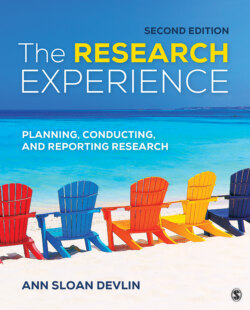Читать книгу The Research Experience - Ann Sloan Devlin - Страница 35
Summary
ОглавлениеWe have considered in depth the qualities of thinking that both may help (schema development; common sense) and hurt (stereotypes; heuristics) our approach to the research process. You have observed the kinds of cognitive shortcuts or heuristics that characterize some decision-making situations and can recognize when those biases may come into play. Exposure to Shermer’s (1997) list of how thinking goes wrong should have made you more attentive to the decisions you will make in your own research. But as researchers likely at the start of your investigative career, you are in a good position to think innovatively because you are less likely than some of your professors to be constrained by a particular way of doing research. You understand the different levels of predictability and generalizability related to laws, theories, and hypotheses. You are ready to begin your journey to combine tradition and innovation.
If you have not had time to consider them earlier, here is the list of Revisit and Respond questions from this chapter.
1.1Explain what it means to say humans are limited information processors.Describe the concept of a schema and its adaptive and maladaptive implications for research.Define heuristics and give examples of representativeness and availability.Explain the Wason Selection Task and what it shows about the difference between confirming and disconfirming hypotheses.
1.2Give an example from each one of Shermer’s (1997) categories:Problems in scientific thinkingProblems in pseudoscientific thinkingLogical problems in thinkingPsychological problems in thinkingOf these four categories, which do you think has the most potential to undermine the research process and why?Explain why science is a combination of tradition and innovation.
1.3Explain the value of common sense in posing research questions.Explain the difference between a law, a theory, and a hypothesis.Explain the qualities of theories, such as scope and parsimony.Describe what makes something a good research question; give an example of what you think might be a good research question and another example of a poor research question.
